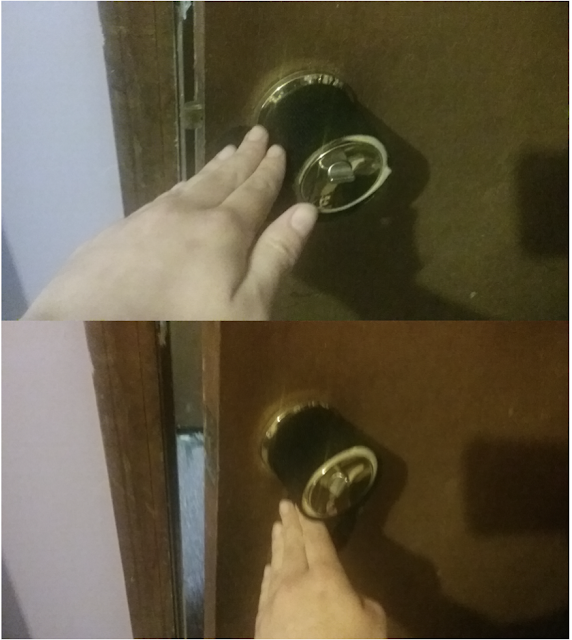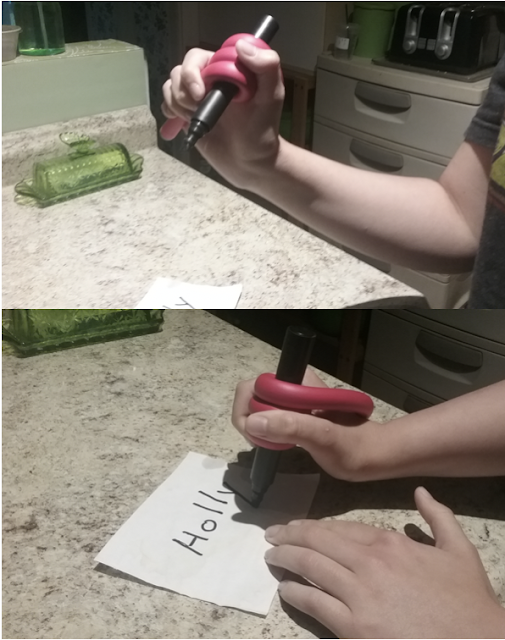Creating Simple Low-Tech AT Devices at Home
By: Holly Bogardus, EC-SEAT Scholar
Once we realize the possibilities of the materials around us, it becomes easier to envision ourselves creating useful tools for those we work with. Assistive devices do not need to be bought, or cost hundreds of dollars. Below you will find a few simple and cheap devices that address an assortment of needs. While looking at these devices I encourage you to consider a problem you or another has or is experiencing, and if there could be a simple solution at hand. Looking at materials in new ways can open many possibilities of utilizing things creatively to increase a person's ability to perform a task, or to be better focused and engaged in an activity. Simple solutions are out there if we can think creatively as well as critically.
This device is designed to change the way in which a marker or other utensil is held. As can be seen in my photos, while using it I felt most comfortable holding it similar to a bicycle handlebar, but it is not necessary to wrap your thumb around in this way. This device eliminates the need for a tri-fold grip and can be used for anyone with grasping impairments caused by arthritis, cerebral palsy, or other disabilities. I found the Industrial Twist-Tie to be very comfortable and easy to work with, it took several times to wrap it around the marker tightly enough to keep it from slipping. I found it awkward having the marker set to the left of my hand, which made writing awkward. To be used for painting and other things I think I’d like to wrap the Industrial twist-tie around the marker or paintbrush in the middle and twist the ends up on each side to allow the handle-bar style grip around the paintbrush on either side and improve writing by having the marker in the middle.
This device is intended to allow persons with grasping impairments to be able to properly groom their pets at home. By using the One-Wrap and wrapping it tightly while torquing the brush and then looping the One-Wrap in the opposite direction to make a handle I can slide my hand in. I kept the soft loop side on the exterior of the brush, to avoid accidental snagging on the pet, and on the inside of the handle for the comfort of use. This solution felt very natural as it simulated the same motion as petting. Once the handle was properly fitted for my hand it was a very comfortable tool to use.
This device was created as a way to allow someone with limited hand strength and grasping impairments to carry in groceries or other like things. This could particularly help someone with arthritis as they can keep their handless tightly clenched and fingers more relaxed. The design allows someone to hold the singular handle in the center and distributes weight on either side, instead of placing the weight and tension (and the digging into your hands) associated with carrying multiple bags., I extended the loc-line to its end range of motion to create a sturdy and comfortable handle. I was then able to push the industrial twist-tie through, forming it around the edges of the lock-line to prevent sliding, and then upturning the twist-tie to create balanced hooks on each end. The loc-line is also better suited as the handle as the twist-tie would eventually start to show wear and tear from use, and cause discomfort to hold as the lining began to deteriorate.
Once we realize the possibilities of the materials around us, it becomes easier to envision ourselves creating useful tools for those we work with. Assistive devices do not need to be bought, or cost hundreds of dollars. Below you will find a few simple and cheap devices that address an assortment of needs. While looking at these devices I encourage you to consider a problem you or another has or is experiencing, and if there could be a simple solution at hand. Looking at materials in new ways can open many possibilities of utilizing things creatively to increase a person's ability to perform a task, or to be better focused and engaged in an activity. Simple solutions are out there if we can think creatively as well as critically.
Visual Complexity Reduction Device
- Materials: Magnets (2)
- Tools: None
Levered Doorknob
- Materials: One-Wrap, Foam, Double-Sided Foam Tape
- Tools: Scissors
Enlarged Light Switch
- Materials: Double-sided Tape, Foam, Corrugated plastic
- Tools: Coro-Claw, Utility Knife
Modified Marker Grip
- Materials: Industrial Twist-Tie
- Tools: None
This device is designed to change the way in which a marker or other utensil is held. As can be seen in my photos, while using it I felt most comfortable holding it similar to a bicycle handlebar, but it is not necessary to wrap your thumb around in this way. This device eliminates the need for a tri-fold grip and can be used for anyone with grasping impairments caused by arthritis, cerebral palsy, or other disabilities. I found the Industrial Twist-Tie to be very comfortable and easy to work with, it took several times to wrap it around the marker tightly enough to keep it from slipping. I found it awkward having the marker set to the left of my hand, which made writing awkward. To be used for painting and other things I think I’d like to wrap the Industrial twist-tie around the marker or paintbrush in the middle and twist the ends up on each side to allow the handle-bar style grip around the paintbrush on either side and improve writing by having the marker in the middle.
Pet Brush Holder
- Materials: Velcro One-Wrap
- Tools: None
This device is intended to allow persons with grasping impairments to be able to properly groom their pets at home. By using the One-Wrap and wrapping it tightly while torquing the brush and then looping the One-Wrap in the opposite direction to make a handle I can slide my hand in. I kept the soft loop side on the exterior of the brush, to avoid accidental snagging on the pet, and on the inside of the handle for the comfort of use. This solution felt very natural as it simulated the same motion as petting. Once the handle was properly fitted for my hand it was a very comfortable tool to use.
Bag Carrier
- Materials: Loc-Line, Industrial Twist-Tie
- Tools: None
This device was created as a way to allow someone with limited hand strength and grasping impairments to carry in groceries or other like things. This could particularly help someone with arthritis as they can keep their handless tightly clenched and fingers more relaxed. The design allows someone to hold the singular handle in the center and distributes weight on either side, instead of placing the weight and tension (and the digging into your hands) associated with carrying multiple bags., I extended the loc-line to its end range of motion to create a sturdy and comfortable handle. I was then able to push the industrial twist-tie through, forming it around the edges of the lock-line to prevent sliding, and then upturning the twist-tie to create balanced hooks on each end. The loc-line is also better suited as the handle as the twist-tie would eventually start to show wear and tear from use, and cause discomfort to hold as the lining began to deteriorate.











nice
ReplyDelete